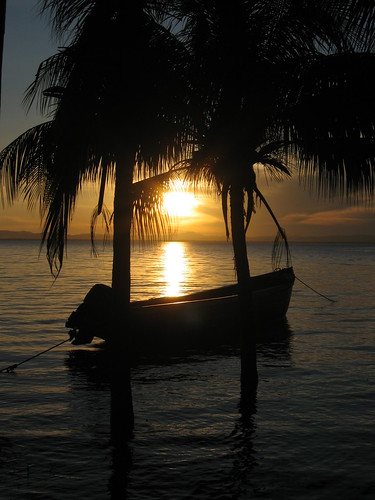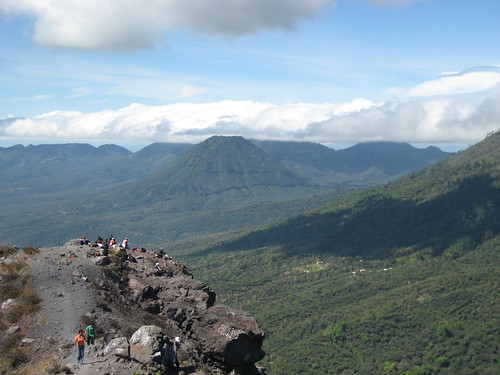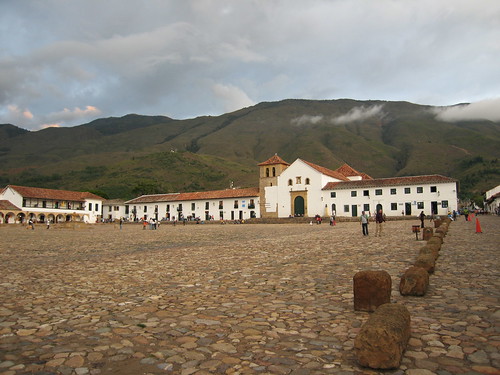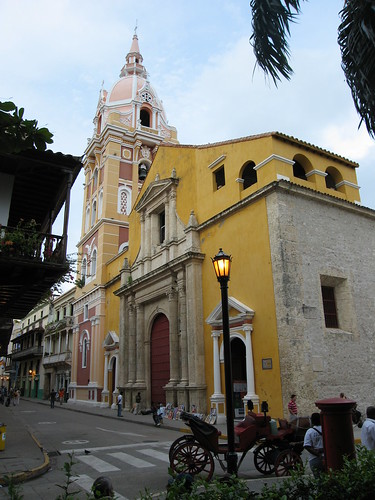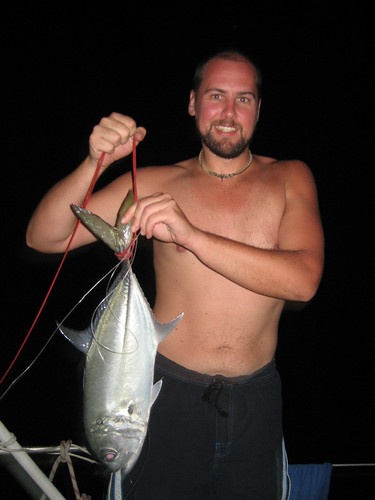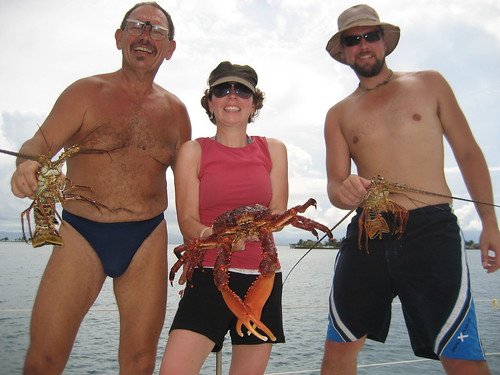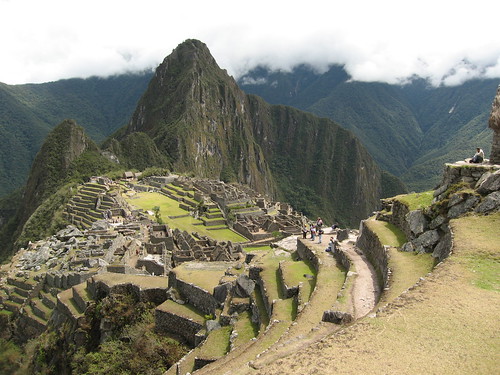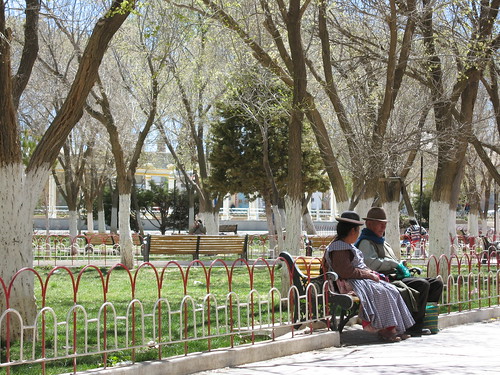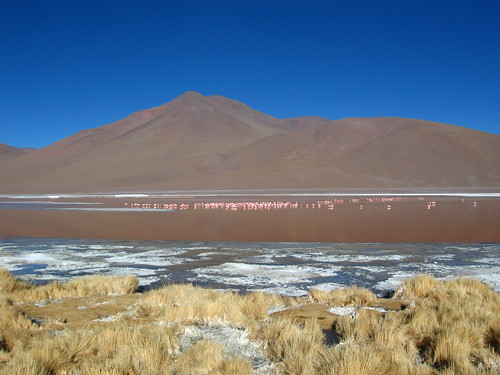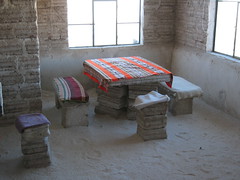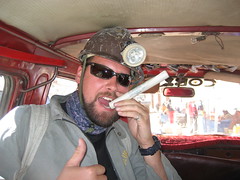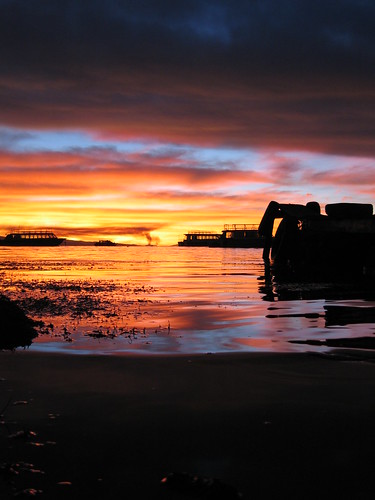Chicken busing through C.A ...
:: Sunset on Isla de Ometepe ::
Our first central American stop was Panama city. We stayed in Panama Viejo, a very old district out on a peninsula. Lots of buildings in the area have been restored but the vast majority are derelict shells with beautiful old facades. The area up until recently was generally considered rundown and unsafe but in a drive to create a tourist area, a highly policed, sectioned off, historical district has been created. More and more touristy related industries are being attracted to the area. The attraction of the area is the fact that you can stroll around the peninsula by the coast admiring the view of ships lining up to enter the Panama Canal. If you do accidentally stray out of the safe area locals are very quick to point you back in the right direction. In fact it's all so coordinated that we started to get really curious about just how dangerous it really was up the road. One thing that stands out about Panama City is how North American it is, Burger King, McDonald's, Popeye, Dunkin Donuts can be found everywhere. Big impressive shopping malls house the shops of all the big brands. High rise condo and apartment blocks have sprung up all around the city.
The next part of the journey was up through Panama, into Costa Rica and on to the capital San Jose before catching an early morning bus to the Nicaraguan border. A school bus ride took us to the shore of Lake Nicaragua and a tiny little ferry bobbed us out to the volcanic Isla de Ometepe. The island is dramatic, two huge volcanoes (one smoking) dominate the small island. Arriving at the port we confidently marched up the road to look for the main town and after a few minutes copped on that we'd been dropped at the wrong port. We started walking along the one road in the direction of the town but were quickly advised by locals that it was "very very far away" but a bus should be along shortly that would take us there. An irregular bus service around the island is an understatement we reached our final destination a couple of hours later. There's not much to do on Ometepe except admire the volcano and explore the island. Unfortunately while we were there the water level in Lake Nicaragua was unusually high so all of the beaches were underwater. We passed on climbing the volcano in the knowledge that we were going to be inundated with opportunities to climb volcanoes further up the road. Instead we opted to rent a motorbike for the day and whizzed around the island, pretty much visiting every nook and cranny.
Once you enter Central America you're in the land of the chicken bus. They are decommissioned old yellow school buses from America which have been colourfully resprayed and given a new lease of life. It's not unusual to still see the old school bus rules up on the wall over the driver but normally the interior is covered with stickers and big religious slogans. They're called chicken buses because... well ....you can bring almost anything onto them. All the old school buses have an emergency exit at the back of the bus. Throughout Central America at every stop or big town a parade of sellers gets onto the bus, nosily proceeds down the aisle and out the emergency exit door and into the next bus. Sometimes ten people will get on all selling the same stuff. Buckets, earrings, drinks, spring onions, bottle washers etc. you name it you can buy it. You often really don't have to move far from your seat to do all your shopping. Another highlight of the chicken bus is being constantly subjected to old Chicago, Phil Colin's and Byran Adams tracks from the 80's.
And so it was to the backing track of Bryan Adams's "Please Forgive Me" that we pulled into Granada city, the oldest city in Nicaragua. Granada is a beautiful old city that's popped onto the tourist radar. The touristy area is a pedestrian street filled with hostels, upmarket hotels and flash restaurants. It's all very lovely but not exactly the real Granada, it's the dressed up version. After searching around for accommodation in the touristy area we got a tip on a place a little further afield. We ended up staying in a little gem of a place Jorge's Hotel right in the local market. Our lodgings and surrounds turned out to be so perfect that we adjusted our schedule to stay a couple of extra nights. Note, our place had the added luxury of a kitchen, en suite bathroom and cable television a far cry from what was available in the touristy area. Proximity to a supermarket that sold top class steaks at ridiculously cheap prices meant we didn't go hungry. We ate out in the market for lunch, again a local tip, hidden deep in the market up a little alley, was a little family restaurant churning out amazing food. The city is also famous for it's local speciality food - vigaron. Busy vendors in the market serve up a banana leaf filled with yuca, cabbage, onions and fried pork skin. It's a traditional filling dish which tastes very similar to the Irish bacon, cabbage and potato dish. Granada was a great stop, not only does it have lots of old world charm, it has a very local feel and if you feel like doing the touristy thing it has lots of restaurants and bars. Even in these food and drink is surprising good value. As the city gets more popular this is sure to change.
Moving on from Granada we connected through the capital Managua to the city of Leon. During the time we were passing though Nicaragua there were presidential elections on and demonstrations in full swing. Nightly on the news there were pictures of young kids with their faces covered, flare guns in hand setting things alight, vandalising property and generally being a nuisance. When we arrived in Managua a rally was about to start, thousands of people were being bused in and the mood was hostile. Luckily we had a quick connection through and out on to the city of Leon. Leon, it's similar to Granada, without the grand buildings it's not quite as majestic. We'd met travellers coming the other way who had raved about the place. Two busy backpacker hostels in the centre seem to generate a bit of nightlife which may make the town a memorable stop for some people. For us Granada was hard to beat, Leon was pretty but just not as happening as Granada. We spend an afternoon wandering around the streets people watching. By nightfall all the demonstrators were arriving back from Managua, creating an edginess on the streets. One street was closed off by police after tyres were set alight. Our biggest regret in Leon was rushing out of it to catch a bus north. Leon's bus station had one of the best food sections in Nicaragua, seafood soup was been dished out and there was lots of meat being barbecued. Maybe next time!! If you're passing through in the meantime please give it the time it deserves.
Our final stop in Nicaragua was the highland city of Matagalpa. Part of the reason we went there was to go into the rainforest at the Selva Negra coffee plantation to hopefully spot some monkeys. We spent a few hours hiking around the plantation and cloud forest and didn't see a dickiebird. Turns out we were over enthusiastic with the scope of our search. All the monkeys were hanging out at the start of the trails near the lodge. When were within 200 metres of the end of our hike we came into earshot of the howler monkeys. The noise these little animals create is astounding and a little frightening when they howl in unison. While we were watching them they moved overhead and pelted berries down at us. Matagalpa itself was a pleasant stop most memorable for it's burger vans which convened nightly in the main square.
We departed Matagalpa very early the following morning in order to give ourselves the best possible chance of making it over the border and as far into Honduras as we could make it - preferably past it's dangerous capital Tegucigalpa. The journey proved to be a marathon of buses, twelve during the course of sixteen hour day of travel, but we did make it to Tegucigalpa and on the smaller safer city of Comayaqua.
Stopping in Comayaqua for the night we recharged our batteries and got ready for another long day of buses connecting through San Pedro Sula. Our next stop was La Ceiba, gateway to the Bay Islands, where we'd planned to do a week or so diving. Utila Island is a famous diving centre with some of the best value courses and fun diving packages in the world. We arrived into La Ceiba to the depressing sight of torrents of flood water running down the road and frequent heavy rain showers. Totally unsuitable conditions for diving as it all leads to murky unsettled waters. Undiscouraged we hung around La Ceiba for a couple of days waiting for the weather to improve before biting the bullet and chancing it in the hope that we'd get a lucky break. Standing on the ferry deck sheltering from a torrential rain shower we were really questioning our wisdom. The small ferry was violently thrown around the choppy waters. Within ten minutes everyone was looking a little peaky. Staff on the boat were monitoring everyone very carefully (plastic bags and paper towels in hand). Half an hour into the journey most people were looking decidedly green but nobody was sick. A little girl suddenly puked and within thirty seconds everyone else simultaneously chucked. The ferry staff very efficiently collected and redistributed sick bags and paper towels. Clearly the situation occurs very regularly.
One of the strangest things about Utila and the Bay Islands is that you suddenly enter into a world of Caribbean influence. English is the main language spoken and everything and everyone is straight off a "Lilt" advertisement. Golf carts ply around the tiny island and to be honest if you're not diving there's not that much to do. Still raining when we got there we waded up and down the road in ankle deep flood water checking out the different dive schools. Despite the weather we signed up for our Rescue Diver Course. The course involved a couple of days of classroom work which would be unaffected by the rain. When we did get into the water to do the practical side of the course we were too busy playing out scenarios and bringing unconscious divers to the surface to worry about poor visibility. On the third day the weather broke and we finally got to see sunny Utila and it's beautiful sunsets. The following days were sunshine filled warm days. We got a few more fun dives under our belts, hunting for seahorses and tackling swim throughs and before we could be tempted into more courses we left for the mainland.
All roads lead to back to the annoying transport hub of San Pedro Sula where we connected on to Copan Ruinas home to Honduras's Mayan ruins. Arrival day coincided with a Sunday and election weekend both contributing to just about every business being closed and Copan Ruinas being as dead as a doornail. ( Interestingly - it seems that in most Central American countries, all businesses that serve or sell alcohol are closed for the 24 hours before election day) Sunday is one of the best days to travel in Central America because everything is shut but it's also the worst time to arrive anywhere because even the busiest of cities can look drab, unwelcoming and very unhappening. Wandering around the dark streets of the town we were just about to throw in the towel and break into our emergency tin of sardines when we happened upon the only street with a bit of food action going on. Street food in the form of baledas, fried chicken & chips and skewers of meat meat with tortillas and salsa was being served up. Eaters sat at plastic chairs and tables while the local population of stray dogs looked on hopefully with forelorn looks. The following day we strolled out to Copan Ruinas to see the ruins. An informative museum houses lots of the artifacts and offers a good insight into life was in ancient Copan.

:: Copan Ruinas ::
Our last stop in Honduras was Gracias, although it proved to be a somewhat briefer stop than anticipated. We spent four hours getting there; arrived and within fifteen minutes we were backtracking out of there. Gracias is located at the edge of the cloud forest, romantic and ecologically attractive as this sounds it must be remembered that cloud forest is simply a forest shrouded in cloud thus the weather is damp and miserable. The one main reason we'd come to Graicas was that a certain guidebook had touted one of it's restaurants as having the best and most authentic slow cooked Hondurian food in the country. The said restaurant was closed, the weather was rainy and miserable and there really wasn't a good enough reason to stop in Gracias for the afternoon so we grabbed a quick lunch of chicken and chips (served up in the back of a garage cum carpentry shop amongst wood shavings) before catching the next bus two hours back up the road. This is far from the first time that we've been in this situation. It's truly amazing how you can spend hours getting somewhere, get off the bus and say "nah.. not for us", and then spend another few hours backtracking. You would think that the four hours wasted on a bus would be mind numbing, somehow it just doesn't register sitting on a bus getting out of there and making headway becomes the priority.
As we were in this neck of the woods we felt the journey wouldn't be complete without a foray into El Salvador. As the smallest country in Central America distances are very very small. Crossing over the border at El Poy we climbed aboard the chicken bus network and made our way south and west towards the city of Santa Ana where we got very comfortable and ended up staying for six days. There were noticeably less tourists in El Salvador, it does have a bad reputation when it comes to murder statistics which naturally keeps a lot of tourists away. It's perfect surfing waves on its Pacific Coast attract surfers but it doesn't quite have the full holistic tourist appeal. Our experience of El Salvador was fantastic, people were friendly, the landscape was beautiful and the food very different. Pupusas are the favoured snack churned out by restaurants. Tortillas filled with frijoles or cheese topped with pickled cabbage and salsa. Santa Ana was a nice small scale city with supermarkets, restaurants, bars - although we're pretty sure lots of them doubled up as brothels. Good bus connections to the nearby countryside made it an ideal base. We made a day trip to the nearby active Santa Ana volcano, by the time the bus had made it to the last stop we at the very top of the mountain and wondered was there anything left we could possibly climb up to. As it happens there wasn't. Climbing Santa Ana involved climbing down the side of the sheer mountain the bus had chugged up and climbing up the neighbouring peak only to descend and climb back up to the bus stop. We didn't know whether to feel cheated or lucky that we got to climb two volcanoes. Either way it was an energetic day out. The good news is that we worked up a hunger for the next day's excursion to the Juayua street food fair. It was so promising that we ended up returning the following day. Sunday proved to be the busier as stall upon stall with everything from Ceviche to frogs cooked up a storm. We tucked into a couple of good wholesome plates of red meat while listening to a band playing. Local women constantly tried to sell us reed reindeers - reminding us that Christmas was just around the corner.
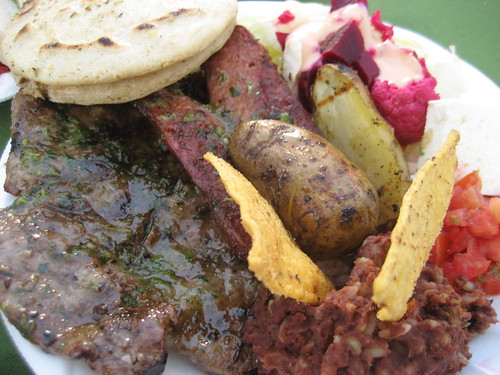
:: Lunch in Juayua ::
After running the clock down in Santa Ana it was time to move north to Guatemala. We had an easy border crossing at Los Manos - surprisingly no one cared about us on the Guatemalan side, you can't get any smoother a crossing than that. As luck would have it there was a chicken bus filling up going to the capital Guatemala. After a speedy start we stopped in a nothing town for half and hour where the driver and conductor rested under tree before we drove like the clappers into Guatemala city.


